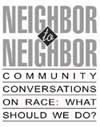
Neighbor to Neighbor, Cincinnati, OH 2001
Partners:
The Cincinnati Enquirer,
WCET-TV (PBS),
WCPO-TV (CBS),
WKRC-TV (ABC),
WLWT-TV (NBC),
Kettering Foundation,
National Issues Forum
A year of extraordinary racial tension in Cincinnati in 2001 prompted an extraordinary response by the city’s media, led by the Enquirer, which collaborated on a project that involved 2,000 local residents in solutions-oriented conversations about race.
The paper had begun focusing on race even before rioting broke out in Cincinnati, publishing a race project March 4, 2001 – just five weeks before mobs took to the streets over the shooting of an unarmed black teenager by a white policeman. With Pew support, the paper worked with its partners to go beyond traditional reporting and facilitate crucial citizen-to-citizen communication.
The partners started the project with a poll in August 2001 of 1,112 adults in Greater Cincinnati. A five-part series, “Divided by Race,” Sept. 2-6, looked at the stark divide between black and white responses. WCPO hosted a panel discussion with live studio audiences in three parts of the viewing area.
The partners followed up the initial reporting project with a second, more solutions-oriented project, “Neighbor to Neighbor.” During October, partners announced an effort to bring together groups of neighbors to discuss race and possibly take some action toward reconciliation. Readers were encouraged to sign up for a session online or through a clip-and-send coupon in the paper. Neighborhood-based conversations began Nov. 11. On Nov. 25, the paper ran its first repot on what people were saying. More readers signed up.
Within four months, some 130 conversations had been held, involving more than 2,000 people. Nearly half the participants held follow-up meetings on their own. One group was meeting regularly. Several of the groups had developed recommendations for action and were exploring joint services between black and white churches and opening lines of communication between neighborhood groups and police. All the major media in Cincinnati, acting as the Cincinnati Media Collaborative, covered the conversations in regular reports or special programming. The Enquirer started regular features, including “Diversity Success Stories” and a weekend “Diversity Report Card” on how the effort was progressing.
To extend the reach of the conversation, the Collaborative partners started a book project, “On the Same Page,” aimed at getting residents to read the same book and attend a discussion group about it. The book chosen was “A Lesson Before Dying” by Ernest Gaines. The effort culminated when Gaines visited Cincinnati in April for a live call-in show on WCET.
Contact:
Rosemary J. Goudreau
Managing Editor
The Cincinnati Enquirer
312 Elm Street
Cincinnati, OH 45202-2410
Phone: (513) 768-8311
Email: rgoudreau@enquirer.com

Under One Roof, Washington, DC 2001
Partners:
Black Entertainment Television (BET),
BET.com
After decades of reporting about the African-American family by white news organizations or think tanks, BET – Black Entertainment Television – tackled the subject in a civic journalism project that combined the forces of the popular cable service’s new newscast and its online division, BET.com. “Under One Roof” was a year-long project that included weekly reports on BET Nightly News tied to interactive features on the Web site.
The project kicked off in November 2001 with a national poll of 724 African-American adults on a wide range of issues from educational aspirations to rap music. The sometimes surprising results won national attention. A majority of those polled agreed with the statement that black men have failed their families, and more than two-thirds said American blacks place too much importance on material possessions. The poll generated stories about the project in the San Francisco Chronicle and other papers and prompted the group 100 Black Men of America to build a town hall forum around the project. Several hundred people, including elected officials and community leaders, attended the forum in Orlando in June 2002. It was taped for broadcast on the Minority Broadcast Company (MBC) cable network.
Weekly reports covered topics such as the impact of high rates of incarceration on black families and black students who were the first in their families to attend college. The Web site hosted message boards where dozens of viewers reacted to the reports. BET.com also previewed topics being explored on the Nightly News and asked users to share their own stories on the issues, which helped guide the television reports. In April and May, the Web site conducted a pop up poll on the Under One Roof page that asked users to rank their top priorities on a number of issues such as education and economic development. Some 30,000 responses were received. The results of the poll were sent to the Congressional Black Caucus.
The project finale was an interactive map the Web site launched in October 2002. Users could navigate it to judge the quality of life for black families in 22 major American cities. The map was assembled over six months using statistics from the U.S. Departments of Labor, Education, Health and Justice and 2000 census data. Online researchers concluded Columbus, OH and Houston, TX had the highest quality of life for blacks, with Baltimore and St. Louis at the bottom. The map allowed users to see how the ratings were decided and comment on them. Dozens of users wrote in, many either to question Boston’s high ranking in third place or defend Chicago, which tied with Milwaukee for 18th.
The project won Best Online News Project from the National Association of Black Journalists and a Cable Positive Award. Its success encouraged BET online and the Nightly News to continue to collaborate on civic journalism projects, including a look at black wealth and a discussion of reparations for slavery.
Contact:
Retha Hill
Vice President, Content, BET.com
BET
2000 M Street, NW – Suite 602
Washington, DC 20036
Phone: (202) 533-1914
Email: retha.hill@bet.net

Building Community from Diversity, Santa Ana, CA 2002
Partners:
The Orange County Register, OCRegister.com
Excelsior
Myoc.com
Reporters developed a deep understanding of the Latino population in the Santa Ana readership area with a community mapping project that included a phone survey, an academic cultural study and a dynamic database of sources structured to stay useful even as reporters move on and off the beat.
The Register announced its mapping project to the community with fliers sent to 750 Santa Ana community groups and through messages sent to community email networks. Then a team of two project leaders, two reporters and a news assistant began the process of in-depth, face-to-face interviews with 100 community members. They also compiled detailed lists of “third places” in the community, where people go to attend to issues important to them and their families and neighborhoods.
The information was entered into a database of community resources used as a newsroom tool. It is cross-referenced by each person’s interest, role in the community and particular affiliation. A hyperlink in each entry connects to the original interview with the source so that the reporter-user can understand the background and context of an issue and the source’s involvement with it over time.
The information was also entered on a literal map, posted in the newsroom and updated each week with stickies showing new places the team found and lists of community assets. The team created a video so the whole staff could learn how to use these resources.
In September 2002, the paper conducted a survey in Spanish of 209 Latino homes in Santa Ana to learn more about life in the community. Meanwhile, a doctoral candidate from the California State University-Fullerton conducted a cultural study of one Santa Ana neighborhood. The paper published stories reporting the results of the survey and study but, more importantly, the project uncovered interesting stories from the community. For example, the Register covered an annual reunion of Mexican American alumni who desegregated a Santa Ana school in the 1950’s after learning about it through an interview. The database also enriched the reporting of other stories. A November 2002 story about immigration done by the paper’s Washington bureau benefited from Santa Ana sources found in the database.
Contact:
Dennis Foley (former Ombudsman for The Orange County Register)
County Government Reporter
The Orange County Register
PO Drawer 11626
Santa Ana, CA 92711-1626
Phone: (714) 285-2862
Email: dfoley@ocregister.com

Invisible Boundaries: Communities of Choice, Fort Lauderdale, FL 2000
Partners:
South Florida Sun-Sentinel
CBS 4 and Newsradio 610
The partners documented the way massive social changes have swept aside the traditional definition of “community” and replaced it with a patchwork of affiliations, raising serious issues for civic institutions.
Though focused on the suburbs of South Florida, “Invisible Boundaries: Communities of Choice” was a story of our times – very much an exploration of the forest, not the trees.
Using information gathered from two focus groups and a survey of 1,000 residents of Miami-Dade, Broward and Palm Beach Counties, the partners showed how factors such as sprawl, technology, immigration and employment options affect how people define and commit themselves to communities.
The research found, for example, that the workplace is more likely than the neighborhood to be the place where people spend most of their time, form their closest bonds, invest energy, volunteer and make charitable donations.
Technological advances allow new immigrants to stay closely connected-through e-mail, cell phones and ease of travel – to their native countries, making them less likely to become civically engaged in their new homeland.
The four-part series ran in the paper and on radio and television over a series of several months, from Aug. 13, 2000 to Feb. 2001. Also in February, the paper distributed a multicultural directory, listing agencies and organizations serving the needs of an ever-more diverse community. Reporters and editors conducted a workshop on the series at a convention of neighborhood activists from around Florida.
Contact:
David Blackwell
Deputy Managing Editor
Sun-Sentinel
200 East Las Olas Blvd.
Fort Lauderdale, FL 33301
Phone: (954) 356-4606
Email: dblackwell@sun-sentinel.com

Inside Oakland, Oakland, CA 1999
Partners:
UC Berekley Journalism School
The Oakland Post
This project not only provided hands-on training in civic journalism, but it also improved coverage of a community usually overlooked by mainstream media. Eight graduate journalism students, enrolled in Berkeley’s “Covering a Community” course in the spring 1999 semester, produced five editions of a supplement to the black-owned weekly, The Oakland Post, called “Inside Oakland.” They also produced ten 30-minute radio shows (also called “Inside Oakland”) for KALX-FM.
Students learned a variety of skills as they were in charge of all aspects of production – writing, editing and lay out. Most importantly, says their professor, Bill Drummond, they learned how to cover a community from the inside. Each student was assigned to cover one of Oakland’s City Council districts. Drummond says they penetrated those neighborhoods and became recognized by the people they were covering. The students held a focus group with 10 of the supplement’s readers to discuss what issues the community wanted covered.
The supplements and radio shows featured stories about an entertainment renaissance in a formerly blighted neighborhood, the efficacy of community policing and the quality of life for elderly in the community. In the final edition, students wrote that the effort was personally rewarding.
Contact:
William J. Drummond
Professor of Journalism
University of California- Berkeley
121 North Gate Hall, #5860
Berkeley, CA 94720-5860
Phone: (510) 642-5710
Email: drummond@rosebud.berkeley.edu
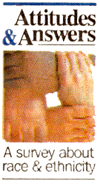
Race Relations in El Paso, El Paso, TX 1998
Partners:
In this largely Hispanic town on the Mexican border, the media partners opened a conversation on race, immigration and language with a series built around a poll of 1,008 residents in English and Spanish.
The first step the partners took was to convene a panel of academic and civic leaders, who met almost weekly through December and January of 1997, crafting the language of the poll’s questions. For example, a question on bi-lingual education was changed from “Do you favor ending bi-lingual education?” to “Do you support bi-lingual education?”
The poll was conducted in February 1998 by interviewers who spoke both English and Spanish. The results were reported in an eight-part series called “Attitudes and Answers,” that began May 10, 1998. The poll found areas of agreement between Anglos and Hispanics but showed a major rift on the issues of affirmative action (most Hispanics supported it while most Anglos opposed it) and language (79 percent of Anglos favored making English the official language of the United States while only 42 percent of Hispanics felt that way).
On May 13, the partners held a town hall forum attended by 160 people, who agreed that though relations between Anglo and Hispanic El Paso residents are generally good, there lingered a subtle racism that was worthy of examination and discussion. Bob Moore, now executive editor, said both the poll and the forum provided the framework for people to feel comfortable discussing the issues.
Contacts:
Robert Moore
Executive Editor
El Paso Times
PO Box 20
El Paso, TX 79999
Phone: (915) 546-6145
Email: bmoore@elpasotimes.com
Kevin Lovell
General Manager
KVIA-TV (ABC)
4140 Rio Bravo Drive
El Paso, TX 79902
Phone: (915) 496-7777
Email: kevinl@kvia.com
![]()
The New City, San Francisco, CA 1998
Partners:
San Francisco Examiner
Maynard Institute for Journalism
After months of ground level reporting, the paper published the first story in the series on April 26, 1998. It was a 175-inch, front page centerpiece that jumped into four inside pages. That first installment also launched a feature called “First Person” that gave people a chance to talk in their own voices. Over the course of the year, the paper published 19 major stories in the series, plus sidebars and “First Persons.”
Editors worked hard to gain strong staff support for the project, even among reporters who didn’t work on it directly. One tool was The New City Tour, a bus tour of some of the city’s more obscure neighborhoods with Max Kirkeberg, a San Francisco State University geographer. More than half the staff took the tour.
Another strategy was to have every department contribute stories to the series, leading to some of the most interesting features, such as a sports department report on cricket, hurling and other exotic, new sports being played in San Francisco’s public parks. The paper had originally envisioned a one year project but felt compelled to continue the series. Stories under “The New City” sig continued to run until the paper was sold in 2000.
Contact:
Sharon Rosenhause (former Managing Editor, San Francisco Examiner)
Managing Editor
Sun-Sentinel
200 E. Las Olas Blvd
Fort Lauderdale, FL 33301
Phone: (954) 356-4602
Email: srosenhause@sun-sentinel.com
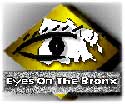
Multi-lingual News Programming, BronxNet, Bronx, NY 1998
Partners:
BronxNet Community Cable
The Bronx Journal
The Multilingual Journalism Program at Lehman College of the City University of New York
In their ongoing and multifaceted effort to give voice to the Bronx’s underserved ethnic communities, BronxNet and the Multilingual Journalism Program at Lehman College launched a multilingual news show and a series of special programs on issues of particular importance to the borough’s residents.
“News 67” was launched in the spring of 1998 in Italian and Japanese. By the fall, a French edition of the weekly television newsmagazine was added and, later, a Korean edition. BronxNet specials included a live, interactive call-in on the future of Northern Ireland in May 1998. In the fall, the partners televised a live discussion of the impact of AIDS on college-age people in a broadcast that linked all 17 campuses of the City University of New York. “Social Security and Generation X,” a month later, linked the campuses with participants in Puerto Rico. For both broadcasts, translators handled questions and comments in Spanish on the air.
Bronx public schools began using Lehman’s student-published newspaper, The Bronx Journal, launched with earlier Pew support, for its Newspaper in Education program, which nearly doubled its circulation of 7,000 to 13,000. This prompted the paper to pilot a children’s section, supported through later Pew funding.
Contact:
Jim Carney
Executive Director
Bronxnet- Lehman College
Carman Hall Room C-4
Bronx, NY 10468-1589
Phone: (718) 960-1180
Email: jcarney@bronxnet.com
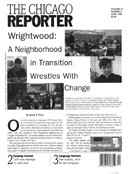
Special Report on Wrightwood, Chicago, IL, 1998
Partners:
The Chicago Reporter
WBEZ-FM
WNUA-FM
The Pew Center provided additional funding to allow the investigative monthly to complete its portrait of racial change in the Chicago neighborhood of Wrightwood. The story appeared in the April 1998 issue. For more details, please see Year Four (1997) projects.
Contact:
Laura S. Washington
3750 Lake Shore Dr., Apt. 8-C
Chicago, IL 60613
Phone: (773) 327-4025
Email: lauraswashington@aol.com

Race in the Yakima Valley, Yakima, WA 2000
Partners:
Yakima Herald-Republic
Immigration has boosted the Hispanic presence in Yakima to 37 percent of the total population. The paper explored the resulting tensions and benefits in a seven-day series, “Race in the Yakima Valley,” Dec. 10-16, 2000. Reporters and editors worked with an ethnically diverse advisory committee to develop questions for a survey of 400 Hispanic and 400 non-Hispanic Yakima area residents. The paper also convened two focus groups.
The focus groups proved to be so rich in insight that the paper created what it called “Listening Post” assignments, requiring reporters to seek out sources never interviewed by the paper before in public places where people congregate. Reporters estimate they spoke to more than 300 people for the project.
Some 80 people phoned or emailed the paper with mostly favorable comments. Yakima’s PBS station aired an hour-long discussion of the Herald-Republic’s stories and the issues involved on day six of the series. The series also inspired the dean of education at nearby Heritage College to look into organizing a round-table group to keep the discussion of race alive.
Contact:
Bob Crider
Managing Editor
Yakima Herald-Republic
114 N. 4th Street
Yakima, WA 98901
Phone: (509) 577-7672
Email: bcrider@yakima-herald.com
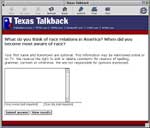
Talking Race: A New Approach, Dallas, TX 2002
Partners:
In “Talking Race: A New Approach,” WFAA wanted to do just that – try something entirely new in encouraging discussions about race. Intrigued by the concept of “video boxes” – portable, self-contained, user-activated TV cameras that have shown an ability to elicit amazingly candid remarks – the station placed its version of the devices in shopping malls in the Dallas area and asked people two questions: What do you think of race relations in America? When did you become most aware of race?
The station used the responses as a jumping-off point for a three-part series and an interactive Web page. It also shared the responses with the Dallas Morning News, which used the “interviews” on the cover and several inside pages of its Sunday Reader section on the first day of the series, Sunday, June 30, 2002.
In addition to the video boxes, the station invited public response to its questions on race through the Web page www.wfaa.com/dialogureonrace. The Web page also asked users to answer one of the following questions: “As a person of color, what responsibility are you willing to take to help reach better understanding between the races?” or “As a white person, what responsibility are you willing to accept for past racial injustice and apply toward a better understanding between the races?” Nearly two dozen non-whites answered the first question and 30 white users answered the second. The full responses were posted on the site along with several of the unedited video box responses, links to other sites, the three-part series and an interview with a Utah-based academic who developed the “Mutual Responsibility Theory” of race relations. The page received 5,000 visits during the three days of the series.
To extend the reach of the series even further, the station involved two talk radio hosts – one with a largely African-American audience on KKDA-AM and one with a largely white, conservative audience on WBAP-AM – in its effort to foster constructive dialogue on race. Both hosts agreed to feature the Mutual Responsibility Theory as a topic for their morning drive shows on Tuesday, July 2.
The final installment of the series documented how the calls to the two stations went from knee-jerk opposition to the idea that all races have some responsibility for improving understanding to more thoughtful, reasoned responses and even some on-the-air soul-searching. Even the conservative radio host ended up urging listeners to reach out more so that “familiarity replaces the unfamiliarity that leads to racist feelings.”
Contact:
PJ Ward
Field Producer
WFAA-TV
606 Young Street
Dallas, TX 75202
Phone: (214) 977-6542
Email: pjward@wfaa.com

Bridges to the New California and The World According to Young People, San Francisco, CA 2001
Partners:
Pacific News Service
New California Media/a>
KALW-FM
San Francisco Chronicle
The partnership gave wider circulation, through the Chronicle’s Sunday edition and through KALW programs, to the diverse ethnic and youth voices gathered by two of the Pacific News Service’s major projects: New California Media and YO! Youth Outlook.
The New California Media (NCM) project distilled the major stories in dozens of ethnic newspapers in the Bay Area, papers such as the Sing Tao Daily, Iran Today, India West, and Philippine News. Beginning in April 2001, the Chronicle ran articles from NCM under a sig called “Bridges to the New California.”
At the same time, the paper’s weekly opinion section, Insight, began running pieces by teenage correspondents from YO! Youth Outlook. The paper debuted the feature April 31, 2001, with four essays on “Rage in the Suburbs.” The essays grew out of a Youth Forum the Pacific News Service sponsored earlier in April, entitled “Rage in the Suburbs: Why is it primarily white, male and aimed at schools?” The forum drew more than 125 high school students, teachers and youth advocates. Seventeen teenagers spoke on subjects ranging from “cliques in my school” to “what’s exhilarating in a mall culture.” The Insight editor attended the forum and commissioned essays from four of the speakers.
The forum also kicked off a series of 15-minute radio segments produced by YO! reporters for KALW, the public radio station owned by the San Francisco school district. Each week, the pieces aired as part of an hour-long show called “Up Front: Connecting Neighborhoods through the New California Media.”
Contact:
Sandy Close
Executive Editor
Pacific News Service
660 Market St, Suite 210
San Francisco, CA 94104
Phone: (415) 438-4755
Email: sclose@pacificnews.org

Focus on the Ethnic Voter and Bay Area Bridges, San Francisco, CA 2000
Partners:
Pacific News Service/New California Media
Pacific News Service seized the 2000 presidential and local California elections to demonstrate the growing political clout of ethnic voters and, in the process, created new outlets for diverse voices in the mainstream media.
Pooling the resources of 100 ethnic newspapers and broadcast stations in the Bay Area, Pacific News Service started New California Media in 1996 to circulate stories among its members. Pew funding allowed the nascent service to step up activities during the election and focus on the impact of ethnic voters.
Newsmaker breakfasts, for instance, gave ethnic media reporters opportunities to meet with candidates and issues experts. A special area of NCMonline.org was dedicated to “Focus on the Ethnic Voter.” NCM-TV produced a series of half-hour shows on ethnic voters, which aired on the Bay Area PBS and Asian-language stations and statewide on CSPAN.
The coverage got the attention of mainstream media and ultimately led the San Francisco Chronicle to create a Sunday section, “Bay Area Bridges,” summarizing and translating stories from the area’s ethnic newspapers, such as India-West, Pakistan Today, Beirut Daily Star and Nichi Bei Times. In addition, KALW-FM gave NCM a Friday slot for a weekly show, “UpFront,” featuring ethnic media reporters, editors and producers.
Contact:
Sandy Close
Executive Editor
Pacific News Service
660 Market St, Suite 210
San Francisco, CA 94104
Phone: (415) 438-4755
Email: sclose@pacificnews.org
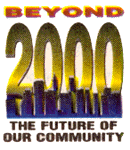
Long Beach Beyond 2000 — Unity in Our Community, Long Beach, CA 1997
Partners:
Long Beach Press-Telegram
Cablevision Industries, Inc.
Long Beach Community Partnership
Leadership Long Beach
First, 25 reporters and columnists each hosted three focus group of about 10 people each. They asked open-ended questions about what issues most concerned people, what solutions they’d propose and how government and other institutions could help. From the approximately 750 people participating in the 75 focus groups, six issues emerged as chief concerns: education, safety, neighborhood quality, race, immigration and youth. The findings were used to formulate a survey of 1,400 Long Beach residents, divided into four groups: 350 Asian, 350 African-American, 350 Latino and 350 white.
An eight-part series informed by the survey and focus groups ran in November and December 1997. Cablevision produced a two-hour program on the initiative.
Contact:
Rich Archbold
Executive Editor
Long Beach Press-Telegram
PO Box 230
Long Beach, CA 90801-0230
TEL: (562) 499-1285
FAX: (310) 437-7892
EMAIL: rarchbold@sgvn.com

Racial Change in Chicago, Chicago, IL 1997
Partners:
The Chicago Reporter
WGN-TV
WNUA-FM
The partners drew a subtle and nuanced portrait of Wrightwood, a previously white neighborhood that had become 50 percent African-American fairly quickly in the early ’90’s, as a case study in racial change in a community. The Reporter, a monthly paper that uses investigative techniques to cover race and poverty, led the team, conducting a statistical analysis that showed the impact of racial change on neighborhood schools and home values. Then, reporters added civic tools to their reporting – convening a meeting of 30 civic leaders and ordinary residents to get input and spending months in Wrightwood interviewing and re-interviewing dozens of residents about their concerns, problems and need, about how they get information, about where conflict exists and what is behind it.
The package of stories was published in the April 1998 edition of The Reporter. On April 15, WBEZ-FM, Chicago’s public radio station, broadcast its story on the Wrightwood community as part of its “Chicago Matters” series. On May 17, WNUA-FM featured Wrightwood on its monthly Sunday morning public affairs show “City Voices.”
The partners wrapped up the project with a July 1 town hall meeting in Wrightwood. About 175 people attended and gave the project high marks for increasing understanding in Wrightwood.
Contact:
Laura S. Washington (former editor and publisher)
3750 Lake Shore Dr., Apt. 8-C
Chicago, IL 60613
TEL: (773) 327-4025
EMAIL: lauraswashington@aol.com

Eyes on the Bronx, Bronx, NY 1997
Partners:
The Bronx Journal
BronxNet
Community Cable
Lehman College
The City University of New York
BronxNet community access cable TV joined forces with the unique Multilingual Journalism program at Lehman College (CUNY) to expand its coverage of this underserved New York borough that, by itself, would have been one of the 10 largest U.S. cities.
Pew funding helped the partners launch “Eyes on the Bronx,” a multimedia effort to cover the Bronx’s diverse communities using civic journalism. A weekly Spanish-language news magazine began airing in April 1997. The cable service also produced periodic specials, such as a 90-minute program on AIDS in the Bronx. The program, “The Changing Face of AIDS,” was produced, in part, by students in the Multilingual Journalism program and was followed by a call-in program, presented on one cable channel in English and simultaneously translated into Spanish on another channel. Bilingual educators and counselors staffed special phone lines and made referrals to appropriate organizations.
The project also launched The Bronx Journal in the fall of 1997. The free tabloid was the first newspaper to cover all of the Bronx, not just a small community within the borough. Each issue featured a multilingual pull-out section presenting hard news in 10 languages including Spanish, Russian, Korean, Chinese and Japanese. The Journal continues to provide multi-lingual coverage and is used in Bronx schools.
Contacts:
Jim Carney
Executive Director
Bronxnet- Lehman College
Carman Hall Room C-4
Bronx, NY 10468-1589
TEL: (718) 960-1180
FAX: (718) 960-8354
EMAIL: jcarney@bronxnet.com
Patricio Lerzundi, Ph.D.
Director, Multi-Lingual Journalism
Lehman College
250 Bedford Park Blvd. West
Carman Hall 266
Bronx, NY 10468
TEL: (718) 960-8215
FAX: (718) 960-8218
EMAIL: lerzundi@alpha.lehman.cuny.edu